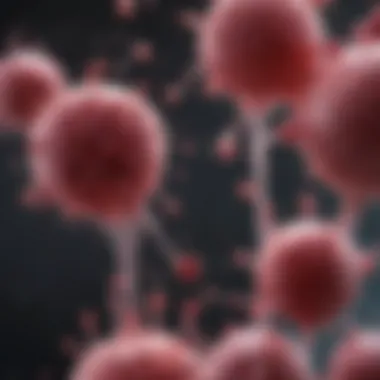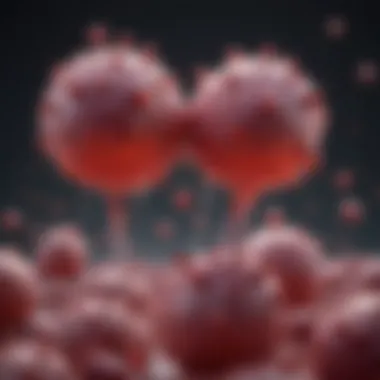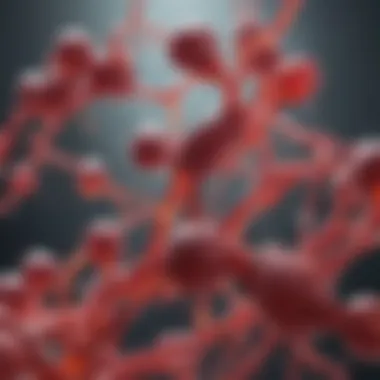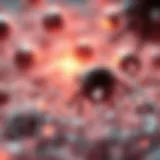Nitric Oxide's Role in Combatting Herpes Simplex Virus


Intro
Nitric oxide is an essential signaling molecule in various physiological processes. Its role extends to the immune system, where it contributes to the body's defense mechanisms against pathogens. The herpes simplex virus (HSV), a common viral infection, poses significant health challenges. Understanding how nitric oxide interacts with HSV can provide insights into potential therapeutic strategies.
Overview of Research Topic
Brief Background and Context
Herpes simplex virus type 1 and type 2 are the two major types of HSV. These viruses can lead to lifelong infections characterized by recurrent outbreaks. Nitric oxide, produced by immune cells, has been implicated in modulating viral replication. Recent studies explore its dual role—both in promoting antiviral activity and potentially influencing the course of HSV infections.
Importance in Current Scientific Landscape
Research on the intersection of nitric oxide and HSV offers promising avenues for developing antiviral treatments. It helps to understand host-pathogen interactions, aiding in devising methods to enhance immune responses against HSV. The exploration of nitric oxide’s effects may inform clinical practices and influence drug development.
Methodology
Research Design and Approach
This article synthesizes findings from various studies that analyze the biochemical interactions between nitric oxide and HSV. Systematic reviews and experimental research provide the backbone for understanding this complex relationship.
Data Collection Techniques
Data have been collected through laboratory studies focusing on immune cell activities and nitric oxide production. Additionally, clinical observations have been reviewed to assess the practical implications of nitric oxide in managing HSV infections.
Recent studies suggest that increased levels of nitric oxide may inhibit HSV replication and may enhance immune system effectiveness.
In summary, recognizing the roles of nitric oxide in HSV infections may pave the way for novel therapeutic strategies. This article aims to illuminate these aspects, contributing to the broader conversation about antiviral therapies and immune response mechanisms.
Prelims
The exploration of the relationship between nitric oxide and the herpes simplex virus is a pertinent area within the fields of virology and immunology. Understanding how nitric oxide functions can uncover potential therapeutic strategies against herpes infections, which remain a global health concern. This section outlines the significance and complexities of the herpes simplex virus, as well as the vital role of nitric oxide in human health, thereby establishing a foundation for the subsequent discussions in the article.
Overview of Herpes Simplex Virus
Herpes simplex virus, commonly referred to as HSV, is categorized into two main types: HSV-1 and HSV-2. HSV-1 primarily causes oral herpes, manifesting as cold sores around the mouth. Conversely, HSV-2 is mainly responsible for genital herpes. Both types have significant implications for public health, as they are highly contagious and can lead to recurrent infections. Once contracted, the virus resides in the body permanently, establishing latency in sensory neurons.
The transmission of HSV occurs via direct contact with an infected individual. This includes contact with lesions or through asymptomatic shedding, where the virus is present on the skin even without visible symptoms. The high prevalence of HSV underscores the necessity for developing new treatment modalities. Some estimates say that a significant portion of the global population carries this virus. Hence, any advances in understanding its pathophysiology could lead to improved management and potentially, eradication strategies.
Significance of Nitric Oxide in Human Health
Nitric oxide (NO) is a crucial signaling molecule in the body, known for its diverse roles in various physiological processes. Its importance spans from regulating blood flow to modulating immune responses, which directly relates to its potential impact on viral infections. Produced by the oxidation of the amino acid L-arginine, nitric oxide serves as a mediator in various biochemical pathways.
In the context of human health, nitric oxide has significant implications. For instance, its ability to facilitate vasodilation aids in cardiovascular health. Moreover, NO plays a critical role in the immune system's response to pathogens, including viruses. It can enhance the activity of immune cells, which is essential for combating infections. Its dual role as both a signaling molecule and a contributor to immune defense highlights its importance. Understanding these roles provides insights into how nitric oxide might interact with the herpes simplex virus and influence treatment strategies.
Biochemistry of Nitric Oxide
Understanding the biochemistry of nitric oxide is essential for grasping its role in various biological processes, especially concerning the herpes simplex virus (HSV). Nitric oxide is a gaseous signaling molecule involved in numerous physiological functions. It plays a critical role in the immune response, acting as a regulator and mediator of various immune pathways. The intricate relationship between nitric oxide and HSV can provide insight into potential therapeutic strategies.
Synthesis of Nitric Oxide
Nitric oxide is synthesized from the amino acid L-arginine through a process mediated by nitric oxide synthases (NOS). There are three main types of NOS: endothelial, neuronal, and inducible. Each type plays a different role in the body. For instance, endothelial NOS is primarily involved in regulating vascular tone, while inducible NOS is expressed during an immune response. The reaction converts L-arginine to nitric oxide and L-citrulline. This reaction is oxygen-dependent and requires cofactors like NADPH. When it comes to viral infections, particularly HSV, the synthesis of nitric oxide can be influenced by various cytokines and immune signals, indicating its dual role in both promoting and regulating immunity.
Mechanisms of Action


The mechanisms by which nitric oxide exerts its effects are multifaceted. One key action is its ability to diffuse rapidly across cell membranes, allowing it to influence neighboring cells. Nitric oxide primarily acts by activating guanylate cyclase, which increases levels of cyclic guanosine monophosphate (cGMP). This pathway is vital for numerous cellular functions, including smooth muscle relaxation and modulation of inflammatory responses.
Moreover, nitric oxide exhibits direct antiviral properties. It can disrupt viral connections and inhibit the replication of viruses within host cells. For HSV, nitric oxide's ability to enhance phagocytosis and modulate the activity of immune cells could play a pivotal role in controlling outbreaks and reactivations of the virus. The precise balance of nitric oxide synthesis and its biological consequences underscores its importance in the complex interplay between host defenses and viral evasion strategies.
Nitric oxide serves as a crucial modulator in the immune response, with significant implications for viral infections.
In summary, a comprehensive understanding of the synthesis and mechanisms of action of nitric oxide lays the groundwork for exploring its potential impact on herpes simplex virus infections. This knowledge is not just academic; it has meaningful implications for the development of antiviral therapies and immune modulation strategies.
The Role of Nitric Oxide in Viral Infections
Nitric oxide, a simple but versatile molecule, plays a crucial role in the realm of viral infections, including those caused by the herpes simplex virus (HSV). Understanding this role is essential, as it sheds light on potential therapeutic avenues and the impact nitric oxide has on the immune system's response to viral pathogens. The significance of nitric oxide lies not only in its function as a signaling molecule but also in its capacity to influence the efficacy of immune reactions against viral infections. This section will delve into the multifaceted interactions between nitric oxide and the mechanisms that underlie viral infections.
Nitric Oxide and Immune Response
Activation of Immune Cells
The activation of immune cells is a pivotal aspect of the immune response, where nitric oxide serves as a key player. When the body detects a viral infection, immune cells such as macrophages and T cells produce nitric oxide as part of their response mechanism. This production is crucial because it enhances the killing efficiency of phagocytes.
A noteworthy feature of nitric oxide in this context is its ability to modulate the activity of these immune cells, facilitating a more robust attack against viruses. By enhancing the function of immune cells, nitric oxide contributes significantly to controlling herpes infections. Moreover, nitric oxide's versatility makes it a beneficial focus in research concerning antiviral strategies.
However, there are some disadvantages. Excessive production of nitric oxide can lead to tissue damage and inflammation. This balance in production must be considered when discussing therapeutic applications, given how crucial both prevention and treatment of symptoms are in herpes infections.
Inflammatory Pathways
The inflammatory pathways activated by nitric oxide are also significant in understanding HSV infections. Upon infection, the body initiates inflammatory responses that are mediated by nitric oxide. This inflammation serves both protective and detrimental roles in the course of the infection.
A key characteristic of these pathways is their involvement in signaling processes that recruit other immune cells to the site of infection. The unique feature of these inflammatory pathways is their ability to amplify the immune response while simultaneously aiding in the containment of the virus during active infections. This dual role becomes essential when examining how to manage HSV outbreaks effectively.
Nonetheless, these pathways can have drawbacks. Chronic inflammation can lead to tissue damage, which complicates recovery. Therefore, while nitric oxide's role in inflammatory pathways is valuable, it demands careful consideration of possible side effects associated with prolonged inflammation.
Direct Antiviral Effects
Nitric oxide also exhibits direct antiviral effects that are becoming increasingly relevant in research. Studies have shown that nitric oxide can interfere with the replication processes of various viruses. This interference occurs through several mechanisms, such as disrupting viral protein synthesis and impairing the replication of viral genomes.
By exerting these direct effects on HSV, nitric oxide presents a promising avenue for developing antiviral therapies. Understanding these mechanisms further enhances our knowledge of how nitric oxide can be utilized effectively in antiviral strategies, particularly against HSV.
Conclusively, the role of nitric oxide in viral infections is intricate. From enhancing immune cell activation to influencing inflammatory pathways and demonstrating direct antiviral effects, nitric oxide serves as a noteworthy molecule in understanding and managing herpes simplex virus infections. Future research efforts must focus on elucidating these interactions further to capitalize on the therapeutic potential nitric oxide holds.
Herpes Simplex Virus: Pathophysiology
Understanding the pathophysiology of the herpes simplex virus (HSV) is vital for grasping its infection mechanisms and the potential role of nitric oxide in treatment strategies. HSV primarily manifests in two forms: HSV-1, typically associated with oral infections, and HSV-2, more commonly linked to genital infections. The pathophysiology covers how the virus enters hosts, its replication cycle, and its impact on the immune system.
Stages of Infection
The stages of HSV infection can be divided into several distinct phases:
- Initial Infection: The virus enters the body through mucous membranes, often during intimate contact or through oral exposure. In this phase, the virus begins to replicate rapidly at the site of entry.
- Viral Amplification: After the initial infection, HSV spreads to neighboring cells and continues to replicate. At this point, the immune system starts to respond, attempting to control the spread of the virus.
- Symptomatic Phase: Symptoms such as sores and blisters may appear during this phase. These manifestations typically arise from viral replication and inflammation triggered by the immune response.
- Latency: Following the symptomatic phase, HSV may enter a latent state, residing in nerve cells. In this dormant state, the virus becomes inactive, avoiding detection by the immune system.
- Reactivation: Upon certain triggers, such as stress or illness, HSV can reactivate, leading to recurrent outbreaks. These reoccurrences often exhibit milder symptoms compared to the initial infection.
Understanding these stages is crucial for developing targeted therapies. Researchers are particularly focused on the transition between latency and reactivation, as interventions at this stage could help manage outbreaks more effectively.
Immune Evasion Strategies
Herpes simplex virus has evolved numerous strategies to evade the host immune response. Key mechanisms include:
- Downregulation of MHC molecules: HSV can inhibit the expression of major histocompatibility complex (MHC) molecules on the surface of infected cells. This tactic prevents immune cells from recognizing infected cells.
- Inhibition of Interferon Responses: The virus possesses proteins that can disrupt the interferon signaling pathway, thus hindering the antiviral actions of interferons. This allows the virus to replicate more efficiently in the host cells.
- Latency and Immune Privilege: By entering a latent state in sensory neurons, HSV avoids immune surveillance. The nervous system is considered an immune-privileged site, further complicating immune detection.


Understanding these evasion strategies is critical for developing therapies that effectively target HSV, especially considering the complexities involved in its latency.
Interplay Between Nitric Oxide and Herpes Simplex Virus
Understanding the interaction between nitric oxide and the herpes simplex virus (HSV) is crucial for grasping the complex nature of viral infections and their treatment. Nitric oxide, a signaling molecule, plays significant roles in various physiological processes, including immune response and inflammation. Its intersection with HSV demonstrates a multifaceted relationship that may influence both the progression of the virus and the host's response. This section focuses on the specific elements of this interplay, outlining the implications for research and clinical practices.
Impact on Viral Replication
The replication cycle of the herpes simplex virus is complex and involves several stages. The presence of nitric oxide can significantly impact these processes. Studies suggest that nitric oxide can inhibit HSV replication through various mechanisms. For instance, it may induce oxidative stress in viral particles, leading to structural damage. Furthermore, nitric oxide can modulate the immune response by enhancing the activity of antiviral cytokines, like interferons.
- Inhibition of Viral Entry: Nitric oxide may help prevent HSV from entering host cells by interfering with the virus's ability to attach to surface receptors. This reduction in entry can lead to lower viral loads during the initial phase of infection.
- Alteration of Viral Gene Expression: Research indicates that nitric oxide can influence the expression of viral genes associated with replication. This modulation could result in a decreased production of viral progeny, consequently reducing the overall viral burden.
These two factors highlight how nitric oxide serves as a potential antiviral agent. However, the effectiveness of nitric oxide in vitro may not always translate to a robust response in vivo. The variability in nitric oxide levels among individuals can lead to differing outcomes in HSV manifestation and severity.
Influence on Latency and Reactivation
The establishment of latency is a hallmark of herpes simplex virus infections. After the initial acute phase, HSV can reside dormant within neuronal ganglia. The reactivation of the virus can lead to symptomatic outbreaks. Nitric oxide appears to have significant implications in this aspect of HSV pathology.
- Role in Latency Maintenance: Some studies suggest that nitric oxide can influence the maintenance of latency. Higher levels of nitric oxide may help keep the virus dormant by enforcing a hostile environment for viral replication.
- Triggering Reactivation: Conversely, certain conditions that raise nitric oxide production in the body, such as stress or inflammation, may act as triggers for reactivation. This dual role complicates the understanding of nitric oxide as strictly beneficial or harmful regarding HSV latency.
In summary, while nitric oxide may inhibit viral replication, it can also influence the dynamics of latency and reactivation in HSV infections. The balance between these effects is critical for future therapeutic strategies. Recognizing how nitric oxide modulates HSV activity could lead to more effective intervention methods that exploit this intricate relationship.
Current Research Insights
Current research regarding the intersection of nitric oxide and the herpes simplex virus (HSV) is crucial for several reasons. It adds depth to our understanding of viral infections, particularly how nitric oxide functions at the biochemical and immunological levels. As an important signaling molecule in the body, nitric oxide participates in various processes, including modulation of immune responses and potential direct antiviral activities. By investigating these aspects, researchers aim to unveil mechanistic insights that could lead to innovative treatment strategies for HSV infections.
Recent Studies on Nitric Oxide and HSV
Recent studies have indicated that nitric oxide plays a multifaceted role in modulating the immune response to HSV. For instance, elevated levels of nitric oxide have been shown to influence the proliferation and activation of immune cells such as macrophages and lymphocytes. In vitro experiments demonstrate that nitric oxide can inhibit HSV replication, although the efficacy varies with the concentration of nitric oxide and the timing of its application in infection cycles. This variability suggests that while nitric oxide is a promising antiviral agent, its application requires careful consideration of dosage and timing to optimize therapeutic outcomes.
Clinical Implications
Clinical implications of these research findings are significant and multifaceted. The exploration of nitric oxide’s roles in HSV treatment opens avenues for therapeutic strategies and potential drug development.
Therapeutic Strategies
Therapeutic strategies focusing on nitric oxide leverage its immune-modulating properties. One key characteristic of these strategies is their potential for synergistic effects when combined with traditional antiviral medications. For instance, using nitric oxide donors alongside antiviral agents may enhance viral clearance and improve patient outcomes. Moreover, nitric oxide’s rapid signaling capability makes it a compelling candidate for adjunctive therapy.
However, challenges remain. The main disadvantage of current therapeutic strategies is the unpredictability associated with nitric oxide levels in patients, which can affect effectiveness. Understanding patient variability requires further study.
Potential Drug Development
Potential drug development initiatives targeting nitric oxide are gaining traction in the medical research community. Notably, the key characteristic of this approach lies in its dual-action capability—both enhancing the immune response and possibly exhibiting direct antiviral activity. The unique feature of nitric oxide-based drugs is their potential application in managing HSV during both the acute and latent phases of infection.
Nonetheless, the development process poses its own hurdles. The main advantage of these drugs is their ability to modify immune responses when appropriately dosed. However, broader clinical acceptance is hindered by the need for extensive clinical trials to determine safety and efficacy, as well as the challenge of standardizing nitric oxide delivery.
Thus, ongoing exploration of nitric oxide's intricate relationship with HSV reveals potential mechanisms and applications that could significantly alter therapeutic approaches.
Challenges in Research and Treatment
The study of the intersection between nitric oxide and the herpes simplex virus presents multiple challenges that are critical to address. Understanding these challenges is vital to the advancement of therapeutic strategies and potential treatment outcomes. Variability in nitric oxide production is one significant factor, as individual responses can vary greatly. This variability affects the consistency and reliability of research findings.
Another substantial challenge lies in the resistance mechanisms of HSV. The virus has developed several strategies to evade immune detection and counteract the potential antiviral effects of nitric oxide. This resistance complicates both basic research and the development of effective treatments.
"The complexity of nitric oxide's role in the immune response and the herpes simplex virus necessitates thorough exploration to uncover viable therapeutic approaches."


Both challenges indicate a need for focused research that accounts for these variables. To overcome these hurdles, it is necessary to consider innovative methodologies and interdisciplinary approaches. By addressing these challenges, researchers can better understand the relationship between nitric oxide and HSV, leading to improved treatment options.
Variability in Nitric Oxide Production
Variability in nitric oxide production significantly impacts therapeutic strategies against HSV. Factors like genetic differences, environmental conditions, and underlying health conditions can lead to significant differences in how much nitric oxide is produced in individuals. Certain cells may produce nitric oxide well, while others might fail to do so effectively.
Additionally, stress factors such as inflammation or infection can modulate nitric oxide levels, and this fluctuating state can complicate treatment protocols. The context in which nitric oxide operates is equally important. For instance, high levels of nitric oxide can be toxic and lead to cytotoxicity, while lower levels may be insufficient for an effective antiviral response.
Understanding this variability will enhance our insights into tailoring treatments that maximize the beneficial effects of nitric oxide while minimizing risks.
Resistance Mechanisms of HSV
Herpes simplex virus employs several resistance mechanisms that compromise the effectiveness of potential nitric oxide-based therapies. One significant mechanism includes the virus's ability to inhibit the expression of antiviral genes. It alters pathways that would typically activate immune responses. By doing so, HSV can survive and replicate within the host despite the presence of nitric oxide.
Another challenge is the virus's ability to enter a latent state, where it remains undetected by the immune system. During latency, the herpes simplex virus is resistant to many antiviral agents, including nitric oxide. Moreover, mutations within the virus can lead to variations that further enhance its resistance to host immune responses and therapeutic interventions.
Therefore, recognizing the complexity of these resistance mechanisms is crucial for devising effective treatments. Developing strategies to overcome these barriers is essential for progress in treating herpes simplex virus infections and enhancing the role of nitric oxide in these therapeutic approaches.
Future Directions
The future directions concerning the relationship between nitric oxide and herpes simplex virus (HSV) are critical for advancing therapeutic strategies and enhancing our understanding of viral infections. As the complexity of HSV and its interactions with nitric oxide continue to unfold, researchers and clinicians must consider several specific elements that can lead to improved outcomes in treatment. The integration of innovative research methodologies, combined with the focus on mechanistic pathways of nitric oxide, holds immense potential for new therapeutic avenues.
Innovative Approaches to Treatment
Innovative strategies are essential to address the limitations in current HSV treatments. One promising approach is leveraging nitric oxide’s potential as an antiviral agent. This could involve designing compounds that can enhance the endogenous production of nitric oxide, thereby boosting the immune response against HSV. Additionally, the development of nitric oxide donors might provide a novel therapeutic modality by ensuring a consistent release of this molecule at the site of infection.
Research has shown that reactivating latent HSV using nitric oxide could weaken the virus and increase susceptibility to antiviral drugs.
Some specific innovative approaches include:
- Nitric Oxide Synthase Modulators: These agents can be adjusted to either enhance or inhibit nitric oxide production depending on the viral stage of infection.
- Nanotechnology Applications: Utilizing nanoparticles to deliver nitric oxide can effectively target HSV-infected cells, minimizing systemic effects while maximizing local efficacy.
- Combining Therapies: Pairing traditional antiviral treatments like acyclovir with nitric oxide-based therapies can provide synergistic effects, leading to reduced viral loads and improved patient outcomes.
Understanding the Nitric Oxide Pathway Further
A deeper understanding of the nitric oxide pathway is vital for unraveling its role in HSV pathology. Investigating how nitric oxide interacts with specific viral proteins can illuminate potential targets for drug development. Additionally, delineating the mechanisms by which nitric oxide influences immune responses against HSV will aid in optimizing therapeutic interventions.
Investing in research that focuses on the following key areas can enhance comprehension of the nitric oxide pathway and its impact on HSV:
- Signal Transduction Mechanisms: Understanding how nitric oxide modifies cellular signaling pathways can offer insights into its antiviral properties.
- Inflammatory Response Modulation: Exploring how nitric oxide impacts inflammation during HSV infections can lead to better management strategies for symptomatic patients.
- Genetic Studies: Investigating genetic predispositions to nitric oxide production may help identify individuals at risk for more severe HSV presentations.
Understanding these various aspects may prove pivotal in refining treatment approaches and developing more effective protocols against herpes simplex virus infection.
Closure
The intersection of nitric oxide and herpes simplex virus presents crucial insights into understanding viral infections and enhancing treatment options. This article has explored the biochemical mechanisms underpinning the interaction between the two entities and highlighted their potential therapeutic implications. By examining the roles of nitric oxide in immune response and its antiviral properties, we have uncovered pathways that warrant further exploration.
Summary of Findings
In summary, nitric oxide plays a multifaceted role in the immune system, particularly in responding to viral threats like HSV. Key findings include:
- Nitric Oxide and Immune Activation: The synthesis of nitric oxide is linked to the activation of immune cells, providing an essential defense mechanism against infections.
- Direct Antiviral Activity: Emerging studies suggest nitric oxide may directly inhibit HSV replication and influence its latency and reactivation.
- Impacts on Inflammation: Nitric oxide's involvement in inflammatory pathways underscores its dual role in both promoting and regulating immune responses.
These findings illustrate that understanding nitric oxide's intricate relationship with HSV could lead to innovative treatment protocols, particularly as viral resistance continues to pose challenges in current therapy.
Implications for Future Research
The exploration of nitric oxide and HSV sets the stage for numerous avenues of research. Future studies should focus on:
- Mechanistic Studies: More in-depth investigations into how nitric oxide modulates viral replication and the immune response can uncover new therapeutic targets.
- Clinical Trials: Evaluating the efficacy of nitric oxide donors and modulators as treatment options for herpes infections should be prioritized.
- Personalized Medicine: Considering individual variability in nitric oxide production could enhance treatment effectiveness and minimize side effects.
By delving further into these areas, researchers can expand the understanding of this relationship and potentially develop more effective interventions against HSV.



